LG V40 ThinQ Review: Three Cameras Aren't Better Than One
The V40 is an expensive camera phone that has a stunning display and solid performance, but its multiple cameras aren't great and the battery life is short.
Why you can trust Tom's Guide
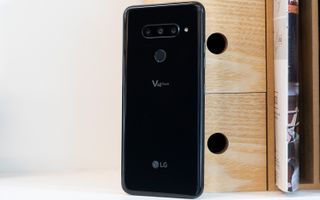
Now that nearly every flagship smartphone sports an edge-to-edge display, what's the next big trend? We're betting on cameras — specifically, the number of cameras arranged on the front and rear of a phone. The days of single lenses are over, but LG's new V40 ThinQ ($920 to $980) proves five shooters may be overkill.
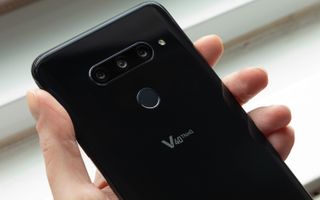
LG's V-series lineup is where the company tends to introduce features designed for serious content producers. The V40 continues that trend with three rear and two front cameras, with a slew of novelty photography features designed to get the most out of all those lenses.
But in our testing, five cameras didn't necessarily deliver more amazing results than three lenses — or even two, for that matter.
Cheat Sheet: What's new in the V40 ThinQ?
- Three rear cameras: The V40 is all about the camera. A 12-megapixel standard lens, 16-MP wide-angle lens and a 12-MP telephoto sit side by side on the back of the V40, and you can easily toggle between them in the camera preview.
- Triple Shot: You can shoot from each lens at the same time, and the V40 will create a video of the end result.
- Cine Shot: You can animate one part of an image with this new camera feature.
- Dual front lenses: A second wide-angle lens on the front of the V40 lets you capture better group selfies without any warping.
- Giant display: The V40 ThinQ's 6.4-inch OLED panel rivals Samsung's Galaxy Note 9 for screen-size supremacy, though it's smaller than the 6.5-inch iPhone XS Max.
Pricing and Availability
LG says that pre-orders for the V40 ThinQ start as early as today (Oct. 3) in some locations, though most carriers we've talked to seem to be starting pre-orders next week. The phone goes on sale beginning Oct. 18. T-Mobile is offering the phone for $920 ($30 a month over 24 months with a down payment of $200), Sprint for $960 (or $20 a month on an 18-month lease for qualifying users), Verizon for $980 (or $40.83 a month over 24 months) and AT&T for $950 (or $31.67 a month for 30 months on the AT&T Next upgrade program).
Regional carrier U.S. Cellular will also sell LG's latest phone for $900.
LG V40 ThinQ Specs
| Price | $900-$980 (depending on carrier) |
| Display (Resolution) | 6.4-inch OLED (3120 x 1440) |
| OS | Android Oreo 8.1 |
| CPU | Snapdragon 845 |
| RAM | 6GB |
| Storage | 64GB |
| microSD | Yes, up to 2TB |
| Rear Cameras | Triple lenses: 12-MP standard (f/1.5), 16-MP wide angle (f/1.9), 12-MP telephoto (f/2.4) |
| Front Cameras | Dual lenses: 8 MP (f/1.9) and 5-MP wide angle (f/2.2) |
| Battery | 3,300 mAh |
| Battery Life (Hrs:Mins) | 8:48 |
| Size | 2.98 x 0.3 x 6.25 inches |
| Weight | 5.96 ounces |
| Colors | Aurora Black, Moroccan Blue |
Camera: Three lenses are not better than one
The V40's camera preview lets you choose between each lens's viewpoint with icons at the top of the screen. If you shoot in Triple Shot mode — found in the bottom menu bar next to options to shoot in Portrait, AI and Google Lens — the camera will capture a shot from each lens separately and also create a video that you can edit and even add music to.
Using Triple Shot, you can't see a preview from each lens, so you're shooting blindly. I tried using this feature multiple times and never got three great results. The V40-created videos were definitely not worth sharing. I took the V40 to a butterfly conservatory in Houston and thought each lens would reliably capture different views of the colorful creatures perched on leaves. As you can see below, only the standard option is (barely) salvageable.

I relied on the telephoto lens to zoom in on Charro, the conservatory's green iguana, and the V40 blew out his orange scales. The Note 9's optical zoom turned in a more detailed image with accurate colors.
The V40 combines images from two lenses to create a Portrait effect in the rear camera and in selfie mode. Neither produced very good results.
Every time I used Portrait to capture artistic shots, like a butterfly perched on a branch or a bunch of flowers in bloom, the effect was unimpressive. The butterfly Portrait turned out dark, especially compared to the one I shot on a Galaxy Note 9. A different angle focused on the background of the conservatory instead of the butterfly I was trying to bring into the foreground. And while you can adjust the V40's Portrait blur intensity, you can't change the area of focus.
The V40 also requires you to be 1.3 feet away from your subject to blur the background, which is too close to capture a truly artistic portrait. The iPhone, for instance, requires an 8-foot distance to bring the subject into the foreground and blur the background, and that effect is much more dramatic. After comparing a shot of flowers in New York City's Bryant Park on the V40 and the Note 9's Live Focus (a portrait equivalent), I switched to the V40's AI mode and captured a much better shot with the camera's standard lens.
Portrait selfies were better, even though the front-facing lenses blew out the background in the image I shot at Bryant Park. (Those are skyscrapers in the background, although you can't tell.) The Note 9's Portrait mode has better color accuracy, but also smooths out my skin in a slightly disturbing way.
I wish LG had focused on making the V40's cameras the best cameras rather than packing a ton of gimmicky photography features into one device. LG's latest phone is easily bested by other camera phones on the market with fewer lenses, such as the Note 9. My pro tip for working with the V40's cameras: Toggle over to AI mode, pick the lens you want to shoot from and hope for the best.
Cine Shot: My favorite photo feature
I still haven't quite mastered one of the V40's unique camera features, Cine Shot, but it's much more fun to play with than Portrait or Triple Shot.
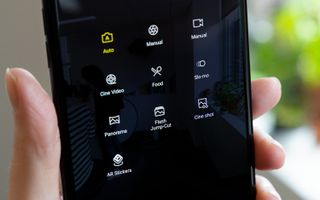
The tool creates something akin to a cinemagraph without the camera equipment, expensive software and technical expertise needed to create an image that moves ever so slightly.

In the V40's camera preview, select Mode from the menu at the top of the screen and then choose Cine Shot from the array of options. A video recording preview will pop up so you can shoot a 3-second clip. After shooting, use your finger to select which area of the clip you want to animate.
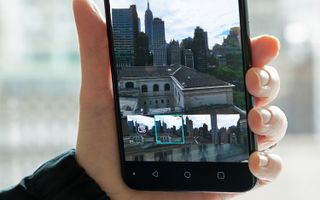
You can spend ages highlighting the video with your fingertip or scrubbing it with an eraser to get the animation spot on, but you can't return to a Cine Shot after saving to edit some more, which would be useful.

My Cine Shots definitely didn't look like a pro took them (maybe because I spent all of a minute working on each one). You can see in this shot of a butterfly that I highlighted too much of the area behind the insect instead of zooming in on the wings. But the effect is definitely more eye-catching than a standard photo. Given enough time with the phone, I'm certain I can create a masterpiece.
Display: A beauty to rival the Note 9
Like the G7 ThinQ, one of LG's other 2018 flagships, the V40 ThinQ has a notch that you can disguise with a software-based bezel. That notch contains the device's two front-facing camera lenses and a speaker. That's nothing special.
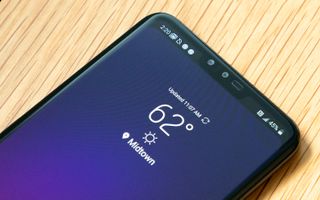
LG decided not to go full OLED with its flagship G7 ThinQ earlier this year, but has since embraced it — first with the V30 and now in the V40. LG's latest device has an expansive 6.4-inch, quad-HD+ (3120 x 1440) OLED display to rival the Note 9's 6.4-inch OLED panel, and the result is pretty impressive.
The V40 reached 571 nits on our light meter, just shy of the scores for the Note 9 (604 nits) and the iPhone XS (611 nits). The G7 ThinQ hit a whopping 900 nits, but its LCD panel didn't wow us outside of the lab.
The V40's screen covers 160.4 percent of the sRGB color gamut and notched a 0.45 on the Delta-E test of color accuracy. (Numbers closer to zero are better on our color accuracy test.) Those are both solid numbers, though the Note 9's display is more impressive, covering 224 percent of the color gamut and scoring a 0.34 on the Delta-E rating. Samsung's displays are more colorful overall — they handily bested the iPhone XS Max, which can reproduce 123 percent of the color gamut.
MORE: Best Phablet: Top Big Screen Phones (6 Inches or Larger)
I streamed the same spooky Chilling Adventures of Sabrina trailer on the V40 and the Note 9 side by side and found them equally immersive. The Note 9 edges out the V40 slightly, due to its curved edges, but both displays captured Spellman Manor's rich, deep blacks and the scarlet red candles on Sabrina's birthday cake.
Battery: Where LG falls short, again
The V40 continues the trend we've seen in every other LG phone these days: underwhelming battery life.
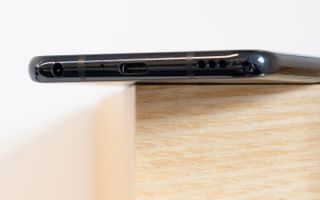
The average smartphone lasts 9 hours and 48 minutes on our test, which involves continuous web surfing over T-Mobile's LTE network until the phone's battery is depleted. Top flagships this year have easily bested that average, with the Note 9 sailing past 11 hours and the iPhone XS Max lasting 10:38. The V40's 3,300-mAh battery is paltry by comparison, lasting just 8:48 on the Tom's Guide Battery Test.
The V40 continues the trend we've seen in every other LG phone these days: underwhelming battery life.
Like the G7 ThinQ (8:35), the V35 ThinQ (9:11) and even the V30 (6:35) before it, the V40 falls short of the battery life we've come to expect from smartphones in 2018. If you're going to spend $900-plus on a phone, its battery has to last. The V40's doesn't.
Design: Same old, same old
The V40 ThinQ is a glossy slab all the way around, just like most phones on the market. It has a giant screen, like most phones on the market. It sports a notch, like, you guessed it, most phones on the market.

There's nothing interesting about the V40's looks, except for its triple-lens camera array, which could catch some eyeballs.
It is incredibly lightweight at 5.96 ounces, especially compared to the hefty, 7.1-ounce Galaxy Note 9, which has the same size display but is beefier overall.
MORE: Best Android Phones - Top Rated Smartphones You Can Buy ...
The V40 won't win any style awards, but it looks like pretty much any smartphone circa 2018, which might be good enough for most people.
Performance: Solid, but doesn't wow
With Qualcomm's Snapdragon 845 processor and 6GB of RAM, LG's V40 easily rivals this year's best Android flagships — on paper.

And the V40 does turn in solid performance with those specs. The device won't blow you away, like the OnePlus 6 and its 8GB of RAM did, but I had no complaints with how the V40 handled apps, videos or games. The V40 scored 8,302 on the Geekbench 4 test of overall system performance. That's in line with the Samsung Galaxy S9+, which has the same specs and scored 8,295. The Note 9 also has an 845 processor and 6GB of RAM and scored 8,876.

In everyday use, the V40 handled tasks with ease. On a quick mission in the graphically demanding PUBG Mobile, there was no lag as I ran around picking up weapons and defending myself against enemies. The brilliant blue of the sky and the green of the trees were stunning.
MORE: iPhone XS Max vs Galaxy Note 9: Which Big-Screen Phone Wins?
The V40 ThinQ is shipping with Android 8.1 Oreo and LG hasn't provided a timeline for when (or if) the new device will be updated to Android Pie. That's another consideration if you're in the market for an Android flagship today.
Bottom Line
LG's V40 ThinQ is expensive. Looking at a spec sheet, the device seems to offer a lot for the money: massive (nearly) bezel-free OLED display, five camera lenses, solid performance with the latest processor and support on every major U.S. carrier.
But in practice, the cameras seem gimmicky instead of high end. The results don't look like they were shot on a DSLR, which has become my bar for an expensive camera phone. With so many other smartphone makers adding (or rumored to be adding) extra lenses to their devices, splurging on this particular LG handset is a decision you may regret in a few months.
The V40's below-average battery life confirms its fate. Spend your hard-earned dollars on a Galaxy Note 9 instead if you're an Android owner looking for a top-performing camera phone, or hold out for the upcoming Pixel 3.
Credit: Tom's Guide
Sign up to get the BEST of Tom’s Guide direct to your inbox.
Upgrade your life with a daily dose of the biggest tech news, lifestyle hacks and our curated analysis. Be the first to know about cutting-edge gadgets and the hottest deals.
Caitlin is a Senior editor for Gizmodo. She has also worked on Tom's Guide, Macworld, PCWorld and the Las Vegas Review-Journal. When she's not testing out the latest devices, you can find her running around the streets of Los Angeles, putting in morning miles or searching for the best tacos.
